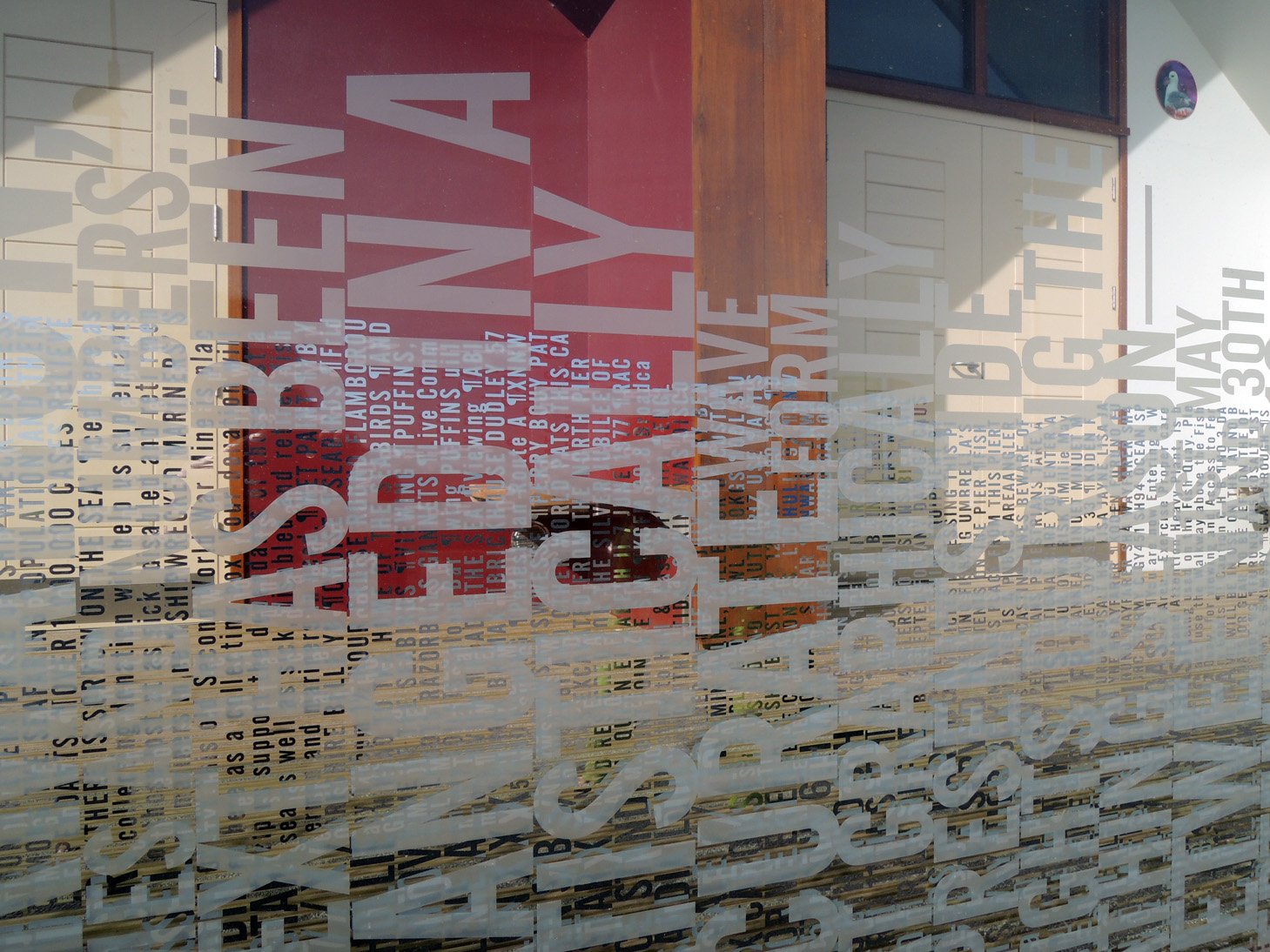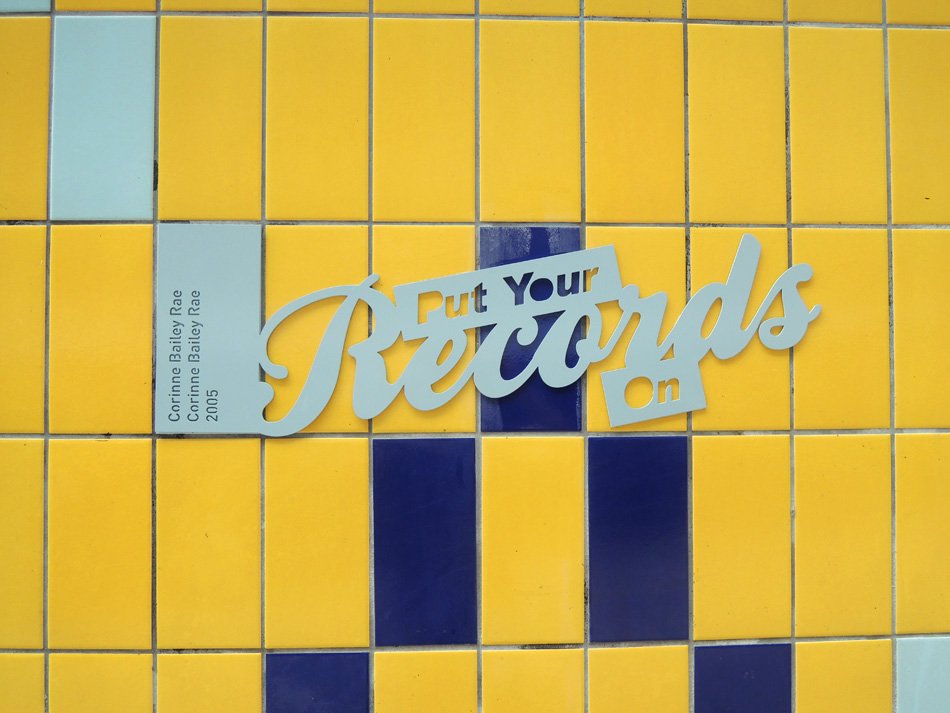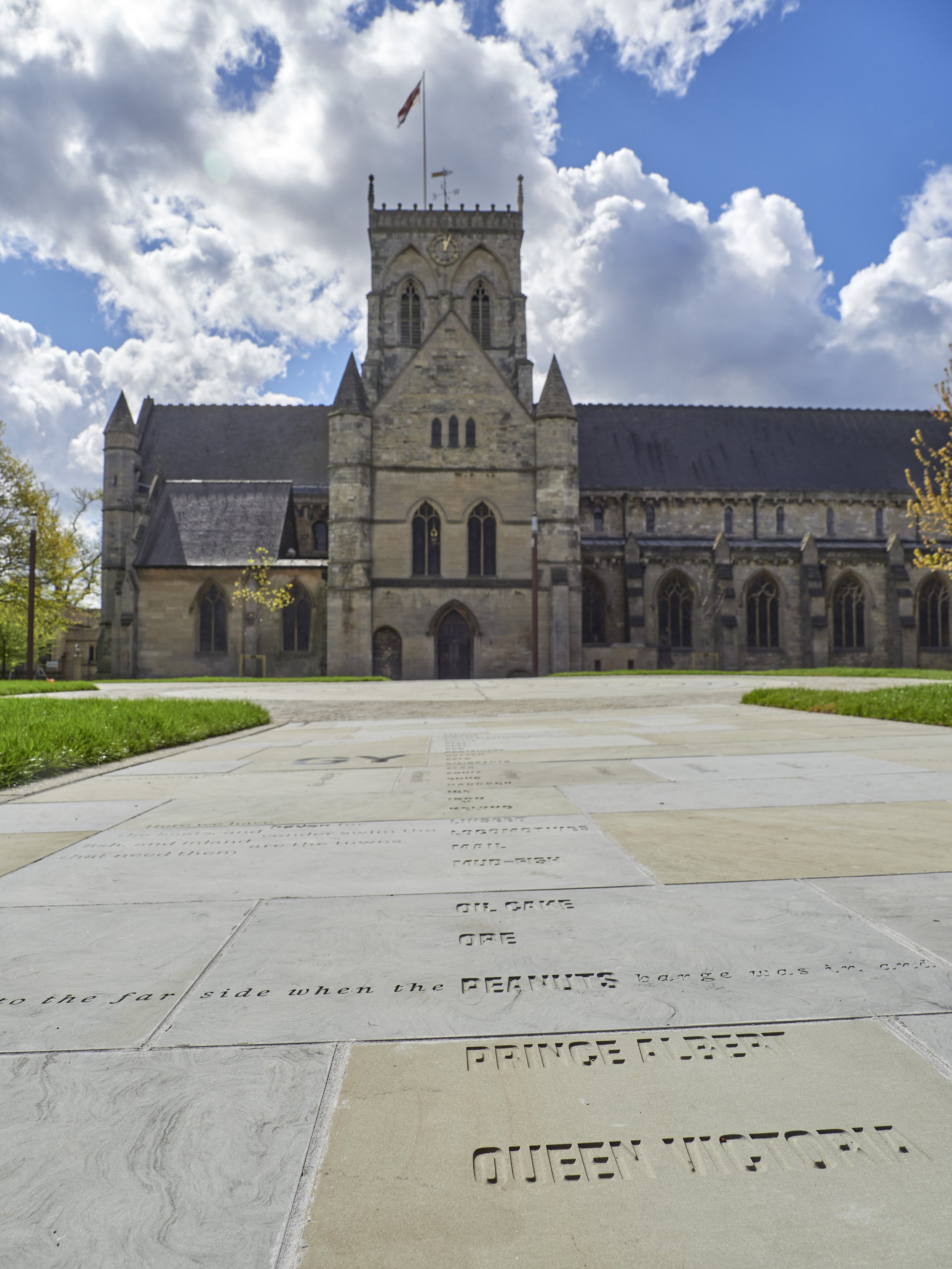ARTIST INTERVIEW: Adrian Riley
Please can you give me an introduction about yourself
I’m Adrian Riley, a graphic designer by training – and I still do branding and design for print – but I’m probably more visible for public art commissions. These are often text-based works, sometimes in collaboration with other creatives – visual artists, poets – and tend to be strongly influenced by graphic design and typography. These projects often involve significant engagement with communities working with people of all ages so that their voice is present in the final artwork. Most are permanent works in public places and can be found across the North of England including Leeds, Newcastle, Bradford, Grimsby and York. They’re usually commissioned by arts organisations, local authorities or organisations such as the NHS, RSPB and English Heritage.
What inspired you to do design?
I think it could have been trains. When I was a little kid, we travelled everywhere by public transport and the railways were kinda exciting to a young boy – Britain was building futuristic high speed trains and British Rail was strong on what we now call branding. There was also a whole tradition of graphic design that went with the railways, everything from logos to posters to train liveries – I remember visits to the National Railway Museum in York being this huge visual overload of lettering and colour and I loved it. I distinctly recall seeing a series of posters from the 1930s promoting the North Yorkshire Coast by the artist Tom Purvis and being totally wowed by those (I recently paid homage in a few temporary artworks in empty building windows and a building wrap in Scarborough). I just wanted to draw lettering and posters from then on. I still don’t get to do enough posters!
RSPB Bempton – linnet 01:
Series of 22 phonetic birdsong panels at RSPB Bempton in East Yorkshire.
Has living in Scarborough influenced your work?
I think the local creative scene is possibly Scarborough’s best-kept secret. It’s so welcoming and supportive. It’s diverse too – there’s a burgeoning digital sector as well as a lot of visual artists (I saw someone quote 200+ recently). There’s enough practitioners really good at their artform to keep you on your toes in yours, and also diversity and inquisitive minds to keep you inspired and stop getting in a creative rut.
The challenge is isolation – most of my public art commissions are outside the borough but that does mean I’m forced to compete on a national level for public commissions which prevents me falling into a comfortable world of just local work, so that works in my favour I guess. It’d be lovely to work on something big locally though that has a real positive impact on the community - I get to do that elsewhere and always think we should be doing ambitious projects like this closer to home. Scarborough is primed to be a real cultural hotspot - it’s strong in theatre, music and visual art – but if we’re to attract people from outside, either as visitors or to join our community, there needs to be some real attention-grabbing projects including ambitious high quality public art.
Describe your creative process; from start to finish of one of your works. Where do you find your inspiration?
Everything is working to a brief. There is a location, a budget, usually a theme too and perhaps some suggested ways of working, materials or people to engage with, you take it from there. The first step is research; both on location and online - I just dive in and start following threads, looking for stories, connections, resonances. These might become the inspiration for the artwork or routes I propose following with the community. The ideas spring out of that. There’s probably a load of other stuff buzzing around in my head too – a mix of what I know works but also things I’m wanting to try out and usually these all combine in an idea. It’s not always visual, ideas for using text might come from music I’ve heard or conceptual ideas I’ve read about. Public art commissions are mostly competitive situations so an idea has to be strong, achievable and communicate really clearly. This might be through visuals or initially just a written description – being able to write creatively as well as draw is essential!
Once I’ve been awarded a commission there’s opportunity to revise it and tighten it up and then start drawing up detailed designs and visualisations. If it’s a project working with the community their influence can shape it significantly which is always exciting and gives the work genuine local resonance - that’s the ideal situation for me. Then I have to make it - I’ve been fortunate to have long-standing relationships with local businesses who have produced much of my work. They’re usually involved early on in proposing something we know can be built and within budget.
What is your favourite piece of work that you have created and why?
I think the most rewarding recently is a 30m long text artwork etched into stone paving outside Grimsby Minster called ‘Come Follow Me’. I was given a lot of creative freedom in creating the text as well as the design - it was a brave move by a council not familiar with commissioning large public artworks. It’s a democratic non-linear telling of the town’s history incorporating everything from the ‘official’ histories such as its C13th origin myth, through to local kids dialect and childhood memories from local residents I met. In the path a teenager’s story of putting washing-up liquid in the square’s fountains has equal weight to the reading of Grimsby’s incorporation bill in the House of Commons or the opening of the docks by Queen Victoria. The lettering styles came from photographs taken by local teenagers around the town but used in a contemporary typographic style – it’s not your typical heritage artwork at all but everything in the path does have local resonance. It also contains a ‘concrete poem’ I wrote playing on the history of the Minster which (I think) was the first time I’d actually written original text for inclusion in an artwork – I usually use text generated with local people, written by a poet, or use found text from research. All this is combined in a design exploring coincidences, ambiguity and nuances and runs from one side of St. James Square right up to the Minster doors.
Who is your favourite artist and why? Do they have an influence on your work?
I’m probably more influenced by typographers and visual poets across history than artists, but Yoko Ono remains a big influence – not in style but her clarity of thought, her use of language, her desire to engage. It’s a crime that many people just think of her as ‘that woman who broke up The Beatles’ (she didn’t) – her work long before she met John Lennon was just amazing and continues to be so. As a former Bradfordian I also admire Hockney for his appetite to try new things – the first work of his I saw was a give-away printed in every copy of the local newspaper. Then I saw his faxed artwork in Salts Mill, then his theatre sets, then his iPad drawings. It’s only more recently I’ve seriously looked at the paintings that launched his career. He’s just such an inquisitive mind who doesn’t see barriers and that’s inspiring.
What has been your biggest achievement so far?
Just making a living doing this. This morning I saw a report that said artists working on public projects earn way below minimum wage. So to be doing this for a job is precarious, but something of an achievement.
‘Leeds Song Tunnel’ – a text artwork of song titles from singers and bands associated with Leeds. Created to mark the opening of Leeds Arena.
What is it like being a full time artist? How do you get yourself out of a creative rut? Do you ever find it lonely working on your own?
Unless you hit a real creative block – which I don’t think has ever happened to me, I tend to think you can only spot a creative rut retrospectively. You might look back and realise you were doing the same thing over and over with no real progression, but for many artists it’s that repetition that’s at the heart of their work. It’s also been a useful route for some designers to get known by repeating a very distinctive style that they apply to most projects. So there’s real value in that, you just have to avoid it becoming a rut. There are some things I like to return to that I can always find something new in – phonetic birdsong is something I love revisiting. For example I recently had school kids rapping bird-song inspired poems expressing what they valued about home – in the past it has been the weird combinations of letters in phonetic birdsong that fascinated me, but this was as much about patterns and rhythms.
Although ‘electric angel design’ is currently just me, collaborations are an important part of my work – nothing beats coming up with an idea as the result of bouncing thoughts about and I love being pushed out of my comfort zone by other creatives. So I’m never really working ‘alone’ – only on some projects and there are constantly messages and emails coming in from collaborators as projects always run concurrently. I’ve been fortunate in meeting other people I love working with – Scarborough-based glass artist Rachel Welford and I have created some really rewarding work together, not least a big stained glass windows work in Sunderland, and I met Grimsby-based artist Annabel McCourt whilst she was also creating an artwork for St James Square and we’ve worked on several commissions together since.
What is the greatest and hardest thing about being a graphic designer?
The hardest is definitely the slog of constantly chasing work. For several years I was fortunate to have regular projects designing for several arts festivals in the area but then the funding for each of these was cut as part of larger funding changes and I was back to having to find new work. I’m not a born salesman and to be honest I think to be a successful self-employed designer you have to have an element of that. The greatest thing is when a client is delighted with your work. I’ve had lovely conversations and emails at the end of projects and you go away feeling good that your designs have made people happy in their work.
‘Tidal Word Wave’- glass balustrade using found words arranged according to local tide patterns, Bridlington. Collaboration with Rachel Welford and Jo Holmes.
Are you working on any new exciting projects?
Yeah, I’m required to keep fairly quiet about this but as I haven’t given any clues elsewhere in the interview as to what it is, I can probably get away with saying there’s a project with Simon Armitage, the Poet Laureate, in progress. I’m also midway through a collaboration with Annabel down near Chesterfield – the birdsong thing I told you about was part of the engagement for that. It will involve 40+ birdboxes featuring pattern, text and colour created by local schoolkids, we brought in ceramicist Iona Calvert to help us out on that one. I’m also just about to go into production for some seating with cut-out text for a skate park in Corby – it’s not a big project but working with the kids there was good fun and we’ve invented a whole new language spoken by ‘sk8liens’ who have come from another planet to use the pump track.
Why do you think art is important in society?
I guess this goes back to the minimum wage thing: the value of creatives working in communities – in all artforms – is hugely undervalued, particularly by the ideologies that influence the current government, and yet sometimes it’s those people and projects that are holding communities together. Look at what got so many people through lockdown – it was the work of creatives: writers, film-makers, songwriters, visual artists. And yet there’s a reluctance to spend public money on anything that doesn’t reap obvious financial rewards (although I’d suggest a happy community is an economically productive one). Now we’re back out in the world together, what is it that’s going to hold us together when there are forces purposely trying to divide us? I believe art plays a vital role in that.
http://www.electricangel.co.uk










